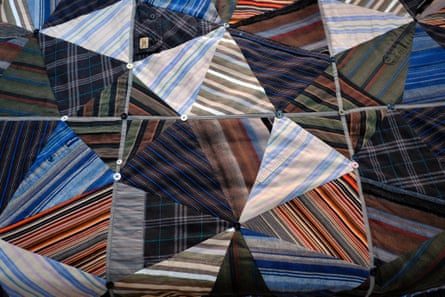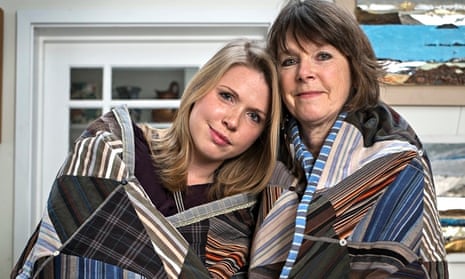Dick didn’t have many extravagances. He lived modestly and spent little on himself – but he did love good-quality stripy shirts. Not deckchair stripes or office-like pinstripes, but stripes in contrasting rich and organic colours that went well together. Only under duress would he wear a tie and cufflinks were out of the question. Shirts were his thing.
Checks were occasionally allowed, and sometimes he indulged in a plain shirt if its colour was irresistible. It wasn’t easy to crack his code of shirt aesthetics: his criteria were exacting but never specific. If we asked what he would like for a present he would say “a shirt like this”, pointing to whichever one he was wearing. He hated to get rid of any of them and took pleasure in continuing to wear them all, without regard for stains and threadbare cuffs and collars.
So, in the aftermath of his sudden death three years ago, disposing of Dick’s shirts caused a particularly poignant dilemma. Our daughters, Ella and Georgia, in their mid-20s when he died, didn’t want to let go of these intimate vestiges of his life. It was as if his character was stitched into the seams. They didn’t want to risk seeing other people walking around in his shirts. Not yet, anyway, they said. So his shirts were stowed in a case in the attic until we were ready to reconsider.
Meanwhile, his overcoat, anoraks, trousers and most of his sweaters slowly found their way to charity shops. Then, last Christmas, when the girls were home together, we were able to reduce the number of shirts to 13 – the ones that meant most.
But what, I wondered, was the point of keeping 13 well-loved shirts in a case in the attic, where no one could see them let alone wear them? Dick liked things to be useful and tried to recycle everything (our greenhouse, for example, is made entirely of old sash windows and secondary-glazing panes we’d had replaced). So it felt wrong to contradict his ideals and leave his shirts packed up as relics; it felt sad, morbid even.

Then, in a moment of enthusiasm, Ella asked if I could make them into a patchwork quilt. She knew I had never completed the quilt intended for her cot nearly 30 years ago, and that I have a habit of leaving grand projects unfinished. This felt too big and too important a job for me, and I feared I couldn’t do it justice – but the idea stuck. We could continue to enjoy the memory of Dick’s sartorial style reconfigured in a format that was useful and had a story to tell. Maybe I could do a cushion cover, I suggested feebly.
I took the thought – and 10 of the shirts – to my friend Louise Charters, a soft-furnisher and upholsterer whose singularly imaginative style is in evidence throughout our house, and who has previously made bespoke quilts. Her creative approach showed me how timid I had been. She saw the potential of the project as a celebration of Dick’s individuality and was delighted and flattered to be commissioned to turn these well-loved shirts into a tribute piece. There would be enough to make a good-sized throw for each daughter.
Where I had envisaged blocks of fabric, she saw a number of inventive designs, which we chewed over. In the end, the composition was completely hers – a repeated pinwheel octagonal design with plain piping (from the ninth shirt) between the sections, and the tenth fabric used as fill-in between them. Moreover, reflecting her own quirkiness, Louise incorporated pockets, cuffs, yokes, buttons and labels to make sure they wouldn’t be seen just as fabric-scraps but retained their elemental “shirtiness”. You can spot a daub of paint on one shirt scrap, on another an indelible food stain.
Though both quilts were identical in composition, she backed them differently so that each was subtly individual. She says, “It was really moving working with such personal material – literally, the fabric of Dick’s daily life. Each shirt reminded me of him in a different way. And it felt good to know that the end product would be a permanent fixture in Georgia and Ella’s lives.”
When women die, there are usually pieces of jewellery or accessories – a scarf, for instance – which close friends or family can keep and wear as a tangible memory. With men, the legacy of personal items is less obvious and less related to their clothing. A watch, perhaps, or a guitar, or a grandfather’s tools may get passed down, but what they leave behind tends not to come from their wardrobe. Yet clothes can be both a distinctive feature of a person and objects of some intimate value.

These memorial quilts have been a brilliant way of keeping Dick’s spirit with us. We can’t summon up his huge laugh or his constant wordplay, but we can remember him bodily in this piece of fabric, and that one.
Both daughters were overwhelmed by the result. Georgia says: “It took a leap of faith to hand his clothes over to get chopped up – I’d hugged him in them and I feared the project would go wrong – but I love them. Wrapping myself up in my blanket is the closest I can get to those hugs again.”
Now, in their own homes, they have a permanent comfort-blanket with a physical link to their beloved father. They could also recognise in them another wonderful example of recycled art, a genre in which Dick had made his own mark, making stunning light-inflecting pictures out of scrap-metal. And here now were these patchworks, part of a long tradition of re-using scrap-fabrics creatively, stitching memories together to produce unique – and functional – artworks.
While Louise was working on the quilts - she spent nearly 100 hours on them, and sewed on 120 of his buttons by hand – she was visited by an elderly friend who was widowed 10 years ago. When Louise showed her our quilts-in-progress, explaining the story behind them, she started to cry. Her husband, a jazz musician, had collected colourful shirts. She had given them all away, with great reluctance, as she’d had no use for them herself. She now recognised that they could have been turned into her own memorial quilt, through which his spirit and style could continue to be present in her home. She loved the idea of getting comfort from lying beneath his shirts and now it was too late.
Women are, historically, the keepers of familial culture and social rituals, and disparagingly called “sentimental” for remembering birthdays and the names of other people’s grandchildren. My writing this story is, on reflection, just such an attempt, sentimental or not, to express and to anchor a stage in our family grieving, as well as to share with other bereaved families the restorative value and comfort of making a memorial quilt. Since our quilts, Louise has made a bedspread for friends in Switzerland in commemoration of their daughter who died at 17 - a joyously bright quilt made with antique Guatemalan fabric they had collected while living there. Each memorial quilt will have its own story.
Meanwhile there are still three of Dick’s shirts – the best – in the attic. Not knowing that our quilts would turn out so well, and how comforting we would find them, we’d held the best of them back. I guess it’ll be another two years before we work out what to do with them.
The quilts can be seen in close-up at www.louisechartersdesign.co.uk

Comments (…)
Sign in or create your Guardian account to join the discussion